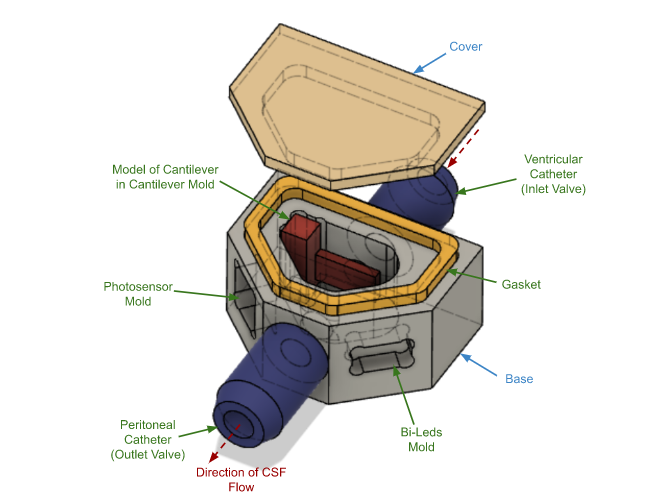

This video contains proprietary information and cannot be shared publicly at this time.
Figure 1

Team 11
Team Members |
Faculty Advisor |
Adrian Aguirre |
Kazunori Hoshino Sponsor Hoshino Lab |
sponsored by
Sponsor Image Not Available
Design of a Smart Shunt Sensor for Hydrocephalus
The purpose of our design project is to develop a shunt monitoring sensor for hydrocephalus patients. The design includes a sensor system and a user interface. The housing unit is smaller and more compact than previous designs to improve patient comfortability, with dimensions of 11.86 mm x 6.85 mm x 3.55 mm. Our design is more geometrically efficient than before. CSF flows at 180 degrees through the device, pushing against the cantilever and causing tip deflection. The flow rate through the shunt is monitored by using a photodiode emitting green and red light (bi-colored LED). The light reflects off of the gold on the tip of the cantilever onto a photosensor. This is measured as light intensity and the data is gathered through Arduino. A standard curve is created which compares the changeable flow rate with its measured light intensity. We observed, as expected, that light intensity and flow rate have an inverse relationship. With no flow, the maximum amount of light falls on the photosensor and as flow increases, the light intensity decreases. Since the presence of blood in CSF can cause shunt complications, the same photo sensor and photodiode are used for contamination detection. A spectrophotometer is created on Arduino that detects contamination. With increased contaminants, there is an decrease in light intensity of the green LED. The data from this design can be sent to a phone which will allow the information to be displayed and send alerts. Today, there are approximately one million patients of hydrocephalus in the US, including large numbers in the pediatric population. Our shunt sensor can provide these patients increased quality of life. The shunt sensor will reduce the need for repetitive and costly treatments due to shunt malfunctions. It will also provide the patient more control over their condition, being able to monitor the shunt themselves and giving them confidence that their shunt is functioning properly.
